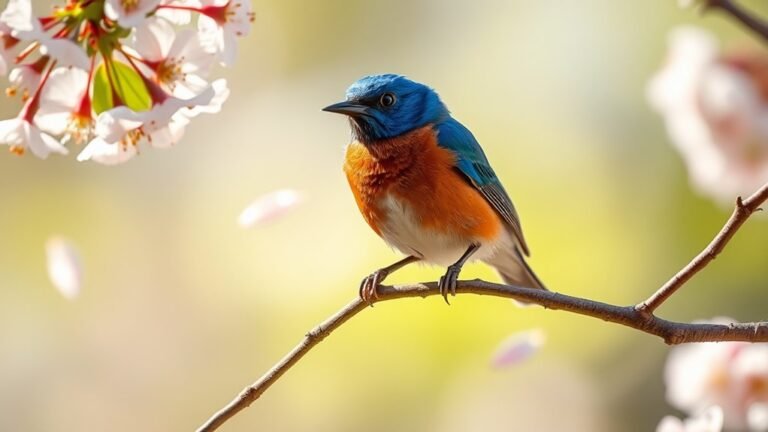Blue Cardinals: Myth or Reality? Facts Explained
Blue cardinals appear captivating, but they are not a distinct species. Their vibrant color comes from genetic changes and environmental factors. These factors create sightings that excite birdwatchers. This article will explain how genetics, habitats, and cultural beliefs shape our views of these birds. What influences the stories and meanings we attribute to blue cardinals?
Key Takeaways
Blue cardinals are not a separate species. They occur due to genetic mutations like leucism or due to lighting effects.
Cultural myths often connect blue cardinals to spiritual meanings, even though they are rare in nature.
Blue cardinals prefer habitats with dense shrubs and nearby water sources. These environments affect how often they are seen and their behavior.
To spot blue cardinals, birdwatchers can listen for their specific calls and look for their feather colors. Using binoculars can improve the chances of sightings.
Birdwatching brings joy and connects people to nature. It helps appreciate the stories and myths related to blue cardinals.
Understanding the Northern Cardinal Species

The Northern Cardinal is known for its bright red feathers, but it also has a variety of color forms, including rare blue cardinals. These colors result from genetics and the bird's environment.
Cardinals show sexual dimorphism; males are bright red, and females are more brownish. This display of color affects their behavior. Male cardinals sing loudly to mark their territory and attract partners. Females focus on nest-building and caring for their young.
Learning about these behaviors helps you appreciate cardinals more, highlighting their vibrant colors and activities. Enjoying these details fosters a deeper connection to these fascinating birds.
What Causes Color Variations in Birds?
Color variations in birds arise from genetics, diet, and environmental factors. One main cause is genetic mutation that changes pigmentation. Different pigments, like melanin and carotenoids, create the bright colors seen in various species.
The diet impacts these pigments; for example, a diet high in carotenoids can lead to more vibrant colors. Environmental factors, such as habitat and climate, also influence how colors appear on birds.
Recognizing these elements enhances our understanding and appreciation of bird diversity.
The Genetics Behind Blue Cardinals

The genetics of blue cardinals involve specific alleles that control their unique color and feather structure. These birds display rare shades because of particular genetic mutations.
Three main factors affect their coloration:
- Allelic Variations: Different gene forms create varied pigmentation in feathers.
- Environmental Influence: Conditions can enhance or reduce these genetic traits.
- Hybridization: Breeding with other species can introduce new pigment features.
Reports and Sightings of Blue Cardinals
Birdwatchers rarely see blue cardinals in the wild. Sightings do happen, but they're uncommon. Many birdwatching enthusiasts share their observations, often describing birds that look blue. This generates excitement and discussion among the community.
Reports of blue cardinals come from different areas, but evidence is limited. Many sightings may actually involve misidentified red cardinals influenced by light or angles.
Discussions about these sightings strengthen community ties and allow members to share their experiences. The desire to spot a blue cardinal keeps birdwatchers engaged. Each new report adds to the mystery, making these birds fascinating to many.
Though blue cardinals may be hard to find, their story continues to thrive within the birdwatching community.
The Role of Diet in Bird Coloration

Diet influences bird coloration significantly. While genetics play a role, dietary choices directly impact a bird's appearance.
Here are three key ways diet affects coloration:
- Carotenoids: These pigments, found in many fruits and vegetables, enhance the yellows and reds in plumage when consumed by birds.
- Color-boosting foods: Birds that eat specific foods retain bright feathers. This brightness is appealing to mates and helps with survival.
- Feeding habits: Different birds have varied diets. Some seek particular food sources for essential pigments that affect their color.
Understanding these points highlights the importance of good nutrition for vibrant feathers. A bird's coloration reflects its environment and feeding habits, connecting us to the avian world.
Enjoy learning about how diet shapes the beauty of birds!
Is the Blue Cardinal an Illusion?
Is the Blue Cardinal an Illusion?
Have you ever thought about the blue cardinal? Many people believe they've seen one, but can it be real? Cardinals are usually red because of the pigments in their feathers.
If you see a blue cardinal, it could be an interesting mix of light and the angle at which you view the bird.
The feathers of some birds can reflect light in unique ways. This reflection can cause our eyes to see colors that aren't really there.
So, a blue cardinal might just be an optical illusion rather than a true species.
Understanding how light works can deepen your appreciation for nature. It shows us how colors and perception can play tricks on us, sparking curiosity about the world around us.
Blue Cardinal Sightings: Myths vs. Reality
Many people report seeing blue cardinals, but these sightings typically stem from myths rather than reality. Here are key points to consider:
- Genetic Mutations: In rare cases, some birds may appear blue due to a condition called leucism, but this is very uncommon.
- Lighting Effects: Sunlight or shadows can create an optical illusion that makes birds look blue.
- Mythological Stories: Different cultures often connect blue cardinals with legends, affecting how people view these birds.
While the idea of blue cardinals is fascinating, most sightings result from misunderstandings.
Recognizing these facts can enhance your appreciation for the vibrant red cardinals that really exist.
Cultural Significance of Blue Cardinals
Blue cardinals capture attention not just for their beauty, but also for their meaning in different cultures. People often associate the color blue with calmness, wisdom, and depth. This connection adds significance to the blue cardinal in various myths and stories.
In many cultures, blue cardinals represent renewal and hope. Their bright colors stand out in nature, reminding us of vibrant life and new beginnings.
Additionally, folklore often sees these birds as messengers. They connect the physical world with the spiritual, providing comfort and guidance.
Such symbolism brings people together, inspiring those who share these beliefs. Therefore, the blue cardinal is more than a striking bird; it carries deep meanings that enhance our appreciation of nature and our role within it.
The Symbolism of the Cardinal in Different Cultures
Cardinals have bright red feathers and symbolize different things in various cultures. Their meanings connect to both spiritual and everyday life.
Here are some key interpretations:
- Spiritual Messengers: Many people believe cardinals are signs from loved ones who've passed away. They can bring comfort during times of sorrow.
- Love and Fidelity: In some cultures, cardinals represent loyalty and passion. They remind us of enduring love.
- Joyful Moments: Seeing a cardinal can signal a coming celebration or important personal insight in certain traditions.
These interpretations show the cardinal's rich symbolism, enhancing our connection to life's experiences.
Whether regarded as messages from beyond or signs of good fortune, cardinals can deepen our understanding of the world around us.
Blue Cardinals in Popular Media and Literature
Blue cardinals appear in various forms of popular media and literature as symbols of hope and transformation.
In stories, authors use their bright colors to evoke feelings of calmness and renewal. In folklore, blue cardinals represent change and act as messengers between the familiar and the unknown. Their vivid colors and rare sightings spark curiosity and encourage exploration of their meaning.
Literature and folklore portray blue cardinals as sources of inspiration, inviting readers to connect with personal experiences of change.
These portrayals foster a sense of community and highlight our shared human journey toward understanding.
The Impact of Habitat on Bird Color
While many factors influence bird color, habitat significantly impacts the vibrant hues we admire. Here are three main ways habitat affects bird coloration:
- Color Intensity: Birds in rich, green habitats often have brighter colors. These colors help them camouflage or attract mates.
- Habitat Diversity: Different ecosystems offer various resources and lighting. This diversity affects feather color and pigmentation.
- Survival Adaptations: Birds change their colors based on predators and their environment. This helps them be visible to mates while avoiding danger.
Understanding the link between habitat and bird color enhances our appreciation for their beauty.
How to Spot a Blue Cardinal: Tips for Birdwatchers
Spotting a blue cardinal is an exciting challenge for birdwatchers. These birds are less visible than their bright red relatives.
To improve your chances of spotting one, try these tips.
First, look in areas where blue cardinals are often seen. They like dense shrubs near water. Listen for their unique calls, which can help locate them. Use binoculars to get a good view of their feathers. The blue color can seem gray or dull in certain light, so be aware of that.
Pay attention to their features, like the crest on their head and their bold beak. Being patient and observant will help you find these rare birds.
Enjoy the experience of birdwatching and the beauty of nature as you search.
Frequently Asked Questions
Are Blue Cardinals Endangered or Threatened Species?
Blue cardinals are not a separate species. Their conservation status depends on habitat loss. Protecting their habitats is essential for the survival of similar bird species.
How Do Blue Cardinals Compare to Regular Northern Cardinals?
Blue cardinals and regular northern cardinals differ in color and behavior. Blue cardinals have a distinct color due to specific genetic factors. They also use unique mating calls to attract mates, which sets them apart from the typical northern cardinals. This difference in their approach to mating adds an interesting layer to their behavior. Both types of cardinals hold charm, making them fascinating to observe.
What Other Birds Are Similar to Blue Cardinals?
Blue cardinals share their habitat preferences with birds like Eastern Bluebirds and Indigo Buntings. These birds enjoy open woodlands and fields. During the breeding season, they display bright colors. You can often find them in similar environments. Their vibrant plumage makes them easy to identify.
Can Blue Cardinals Breed With Other Cardinal Color Variations?
Blue cardinals can breed with other types of cardinals. Their genetics affect their breeding patterns, leading to different offspring. This mixing creates a variety of birds, which helps improve local environments and encourages a stronger bond among bird populations.
Where Can I Report a Sighting of a Blue Cardinal?
If you see a blue cardinal, you can report your sighting to local birdwatching groups or websites like eBird. These organizations keep track of bird sightings and offer an easy way to report where you saw them. Sharing your sighting helps other bird lovers and contributes to wildlife research. Enjoy watching the beauty of nature!

Ava is a bird enthusiast and nature lover who has spent countless hours observing and learning about the fascinating world of birds. With a passion for sharing her knowledge and inspiring others to appreciate the beauty of birds, Ava writes about her experiences and insights on avianadmirer.com.







